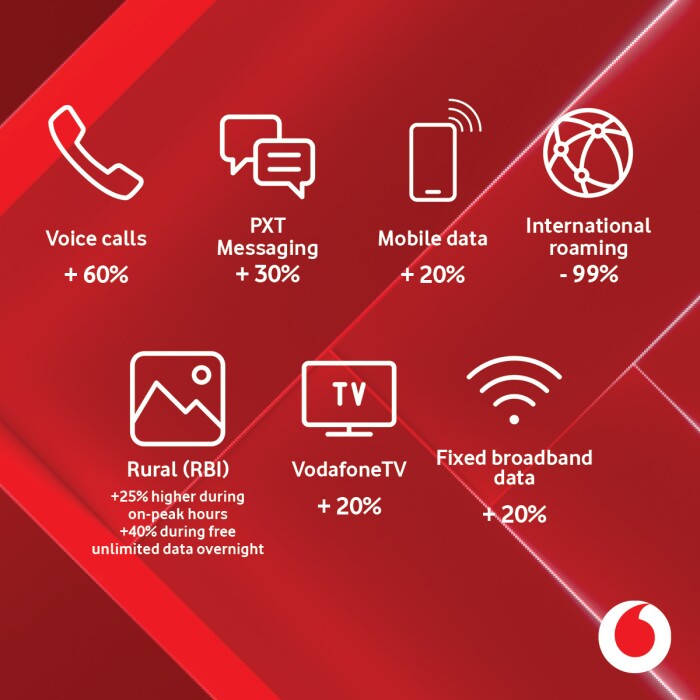We’re continuing to see significant increases in calls and data on the Vodafone networks as we head into the second weekend of level 4 lockdown.
At Vodafone, we have hundreds of technology staff working from their homes around the clock to ensure our customers stay connected – with most network traffic continuing at between 20-100% higher than February levels….with the exception of international roaming!
Overall our network status is green, and while we do have some rural cell sites showing full utilisation, we are managing this with various technology and traffic management initiatives.
Compared to February 2020 levels, we’re seeing:

To handle these sustained extra demands, we’ve been adding more capacity and changing the way we manage voice and data traffic across our complex network of fibre optic cables, interconnect and peering links, international links, mobile base stations, core exchanges, and customer connectivity, security contact centres, and unified comms technologies. This includes investing time, resources and money into optimising capacity for our customers.
You hopefully will only see the benefits of these changes – and we’re working incredibly hard in the background to keep Kiwis connected at all times of the day, no matter how many other people are online in the same area.
But if connections seem slower than usual, it’s worth checking that your Wi-Fi is set up correctly, or thinking about how many other people in your household are accessing the internet or streaming data – and we’ll continue to share tips to help you manage usage and maximise your personal home Wi-Fi.
Changing behaviours during level 4 lockdown
Usually, a large number of New Zealanders travel from their homes to their workplaces, so we make sure we have the most mobile capacity where they are – in town centres, near offices, shopping malls and so on. In this scenario we don’t need as much capacity during the day near the places where they live.
But COVID-19 has turned this pattern of behaviour completely on its head. As a result, we are seeing data use start much earlier in the day – and overall around 20% higher data over our fixed and mobile networks, a whopping 60% more mobile voice calls, and 30% more PXT (picture) messages sent.
While last week we were seeing fixed data up 32% overall, this has settled down as Kiwis spend more time at home and use their home Wi-Fi connections.
After announcing that we’d support our customers to stay connected via a range of initiatives, we’re proud we can offer most customers access to unlimited broadband at some point every day for no extra cost – so we’re managing these increased demands within our operating cadence.
Adapting to traffic peaks
When we talk about network capacity, think of a road – the more lanes on a highway, the more cars can drive down it. So while highways in the city can transport thousands of cars each hour, a gravel road in the country takes fewer cars and is slower. And when there’s lots of cars, there are traffic jams. That’s capacity.
Now imagine lots of roads of different lengths and widths. Rather than trying to force all the cars down one road, you want to spread them across a range of routes where possible to reduce congestion. Or we might need to build more new roads, via increased investment in network infrastructure.
And as the volume of cars changes throughout the day, our network traffic shifts – just as you might choose to drive down different roads to avoid travel delays.
So when one part of the network is very busy, we can try redirect some of the traffic down a different road that isn’t so busy. Or we can try to reduce the number of cars/users placing strain on the roads/network at any one time.
This does mean that parts of the network are incredibly busy – like our rural broadband infrastructure, which runs over a mobile connection instead of a fibre network in urban areas. Which is why we need to keep data caps on during the day, so that everyone else who relies on that same mobile cell site for connectivity can also get online for essential work or education purposes.
New Zealand’s traffic peaks
Because video streaming platforms like Netflix and YouTube, or online games, take up the most amount of data, our busiest times are in the evenings when most Kiwis turn on their TVs or turn online for entertainment.
Our network traffic builds throughout the day – with 9pm usually being our busiest time.
However with COVID-19 meaning Kiwis are now working or learning from home, we’re seeing traffic start to build earlier, from 9am onwards and increase throughout the day. Overall we’re seeing 20-30% higher levels of data than we saw in February.
Likewise, with people picking up the phone instead of talking to their work colleagues, we’re seeing around 60% higher phone calls throughout the day – and doubling to +100% at busy times (11am being the busiest time daily). VodafoneTV viewing is consistently 20% above pre-lockdown levels.
Yesterday at 7pm, we hosted our first Vodafone Lounge Jams with Tiki Taane, a live stream concert series featuring some of our best home grown Kiwi talent. Facebook traffic is up 20%, showing Kiwis are turning to these sorts of activities on social media to connect, and we’re looking forward to next week’s concert featuring Hollie Smith.
While our network infrastructure is designed to support peaks, sustained higher levels of calls and data add a whole range of extra costs.
International roaming declines to almost zero
It’s not all growth, as on the flipside, international travel has reduced to essentially zero so it’s inevitable this will also mean international roaming is down -99%, from both an inbound and outbound perspective.
We expect few Kiwis will travel overseas during our traditional winter peak period – and there will be a lack of tourists entering New Zealand using their international phone provider’s agreement with Vodafone NZ, or buying a travel SIM.
Thankfully Aotearoa almost got through the summer peak of international tourists travelling here, but the roaming impact will depend on how long travel restrictions are in place.
Working hard, to keep you connected
Overall, our engineers are doing a brilliant job adapting our fantastic network to these changing, and unprecedented circumstances.
We have the technology and the expertise needed to keep New Zealand connected during these difficult times – and we’ll keep investing in a wide range of measures to keep our technology infrastructure stable for customers.
Stay safe, stay home, stay connected.
-ends-
